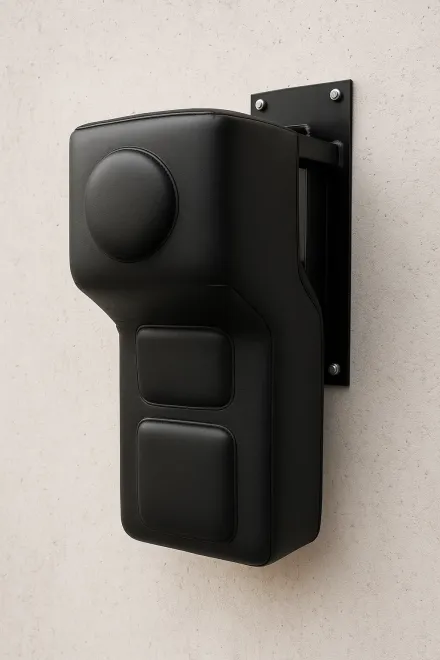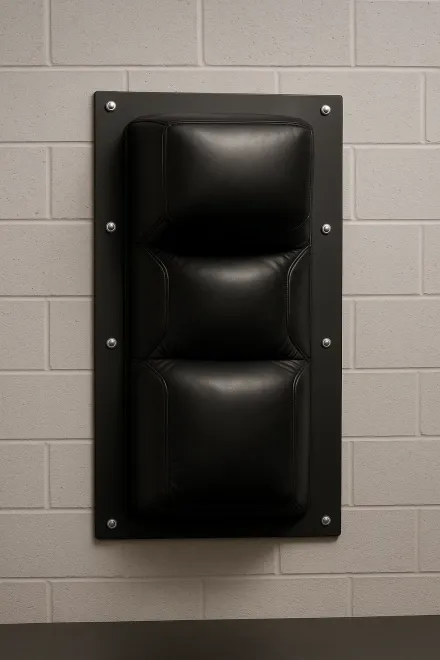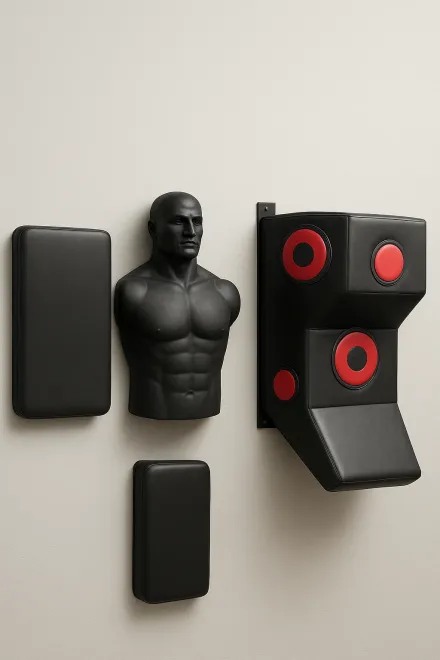Wall boxing bags
Wall boxing bags are a practical, versatile solution for training at home or in the gym without a traditional hanging bag. Their design enables intense work on punches and combinations, offering stability, durability, and space savings. In addition, they are ideal both for beginners looking to improve technique and for experienced boxers who need an effective complement to refine power, speed, and precision. If you are considering adding this gear to your routine, this guide covers everything you need to know: benefits, types, installation tips, and the best models on the market.
See wall boxing bags on Amazon
What is a wall boxing bag and why choose one?
A wall boxing bag is a fixed bag installed directly on the wall using brackets or anchors, avoiding the need for chains, reinforced ceilings, or water/sand bases. This format makes it an excellent option for those without much space at home or in the gym. Unlike hanging bags, wall bags provide a rigid or semi-rigid surface, ideal for training power, precision, and strike endurance. In addition, installation is usually simpler and more stable than other alternatives, ensuring safer, more effective sessions.
Choosing a wall bag also means reducing vibrations and excessive bag movement, which is very useful in homes where noise can be an issue. They also tend to have a compact design that lets you work punches, short combinations, and boxing movements without needing too much free space around you. For all these reasons, they are a smart investment for boxers, mixed martial artists, kickboxers, or fitness enthusiasts seeking better conditioning.
Benefits of training with wall boxing bags
Wall boxing bags offer multiple training benefits, both technical and physical. These are some of their main advantages:
- Space saving: fixed to the wall, they do not require large areas or reinforced ceilings.
- Greater stability: with no swinging, they allow more controlled work on precision and power.
- Easy installation: you just need a solid wall and the right anchors.
- Durability: commonly built with tough materials like synthetic leather, vinyl, or reinforced PVC.
- Safe training: sudden movements or bag falls are minimized.
In addition, a wall bag is excellent for those who want to train at home without bothering neighbors or family. Unlike hanging bags, they do not make as much noise when struck nor transmit vibrations to ceilings or floors. For these reasons, more and more people choose them as part of their home boxing setup.


Types of wall boxing bags
Not all wall boxing bags are the same. Depending on your experience level and training goals, you can choose among different formats:
- Flat bags: padded, rigid surface, ideal for straight shots and classic boxing combinations.
- Anatomical bags: mimic a torso silhouette, allowing hooks, uppercuts, and varied angles.
- Wall shields or pads: common in martial arts, they offer multiple impact points and extra resistance.
- Angled bags: slightly tilted forward to facilitate upward strikes and improve technique.
Your choice will depend on your discipline, available space, and objectives. For a versatile home bag, flat or anatomical models are usually the most recommended. If you train MMA or kickboxing, a wall shield that can handle kicks and knees may be more useful.
Tips for choosing and installing a wall boxing bag
Before buying a wall boxing bag, consider aspects that will affect both your training experience and the product’s lifespan:
- Material: go for high-quality synthetic leather or reinforced vinyl, as they better withstand impact and wear.
- Filling: the most common combine high-density foam with fiber layers, ensuring solid impact absorption without losing firmness.
- Size and thickness: make sure dimensions fit your space and striking height.
- Mounting hardware: verify the bag includes a sturdy fixing system with quality anchors to avoid detachment.
- Suitable wall: ideally mount on load-bearing concrete or solid brick walls, avoiding drywall partitions.
For installation, measure height according to your stature and the punches you want to practice. Also leave free space on the sides so you can move and train combinations comfortably. A good tip is to wear proper gloves even in short sessions, since wall bags are usually firmer than hanging bags, reducing the risk of hand and wrist injuries.
Regarding maintenance, wipe the bag regularly with a damp cloth and avoid direct sun or moisture to extend its life. If you notice the filling compacting too much, some models let you replace it or add foam layers to keep striking comfort.
Who should use a wall boxing bag?
A wall boxing bag is recommended for different user profiles depending on their goals and needs:
- Beginner boxers: ideal for learning technique and precision without worrying about a swinging bag.
- Advanced athletes: useful as a complement to build power and train specific combinations.
- Mixed martial artists: allows short punches, elbows, knees, and even some kicks depending on the model.
- Home trainers: its compact design is the best alternative when there is not enough space for a hanging bag.
- Training centers: provide a safe, durable resource for group classes or one-to-one sessions.
It is also an excellent option for those seeking intense cardio and endurance workouts. Regular wall-bag use improves aerobic capacity, coordination, and agility, while toning arms, shoulders, and core. Even if competition is not your goal, this type of bag is an effective tool to relieve stress and stay fit. In short, whether you are a beginner or a long-time boxer, a wall bag can become the perfect ally to optimize your training in any space.
Frequently asked questions about wall boxing bags
Is a wall boxing bag better than a hanging one?
It depends on your needs. A wall bag offers more stability, takes up less space, and generates less noise, which makes it ideal for home training. A hanging bag, by contrast, allows a wider range of movement and swing, useful for practicing footwork and fight rhythm. In short, if you want power, precision, and convenience, a wall bag is excellent; if you want to simulate a more realistic bout, a hanging bag may be more appropriate.
What kind of wall do I need to install a wall boxing bag?
The wall must be firm and resistant. The best choice is mounting on load-bearing concrete or solid brick walls. It is not advisable to fix it to drywall or light partitions, as they will not withstand impacts and could be damaged over time. If you are unsure about your wall type, consult a specialist or reinforce the surface with additional supports.
Can you train kicks on a wall bag?
Yes, but it depends on the model. Some wall bags are designed only for boxing, with a flat surface intended for punches. However, there are wall shields and reinforced models that allow training kicks, knees, and mixed-martial-arts techniques. Before buying, check the manufacturer’s specs to ensure the bag can handle this kind of impact.
Do I need gloves to train on a wall bag?
Yes, you should always use gloves when training with a wall bag. Unlike hanging bags, these are usually firmer and less padded, so the risk of knuckle and wrist injuries is higher. Even for short sessions, it is best to use training gloves or wraps to protect your hands and avoid discomfort.
What maintenance does a wall boxing bag require?
Maintenance is quite simple. Wipe the surface with a damp cloth after each session to prevent sweat and dust buildup. It is also wise to periodically check anchors and screws to ensure they have not loosened with use. If the filling loses firmness, some models let you replace it or add extra foam layers. With these basics, a good wall bag can last for many years.
Is a wall boxing bag suitable for beginners?
Yes, it is an excellent choice for beginners. Being fixed, it does not swing, which makes it easier to practice striking technique without distractions. It also helps build strength and coordination in early sessions. That said, start progressively and always use proper hand protection to avoid injuries.
What is the difference between a flat and an anatomical wall bag?
A flat wall bag has a uniform padded surface, ideal for straight punches and basic boxing combinations. An anatomical bag simulates a human torso, with contours that let you practice hooks, uppercuts, and different attack angles. Both are useful, but the anatomical type is often more versatile for those who want to train a wider variety of strikes.
Can I install a wall boxing bag in my apartment?
Yes, as long as you have a solid wall and respect house rules. Unlike hanging bags, wall bags produce less noise and vibration, so they are better suited to apartments. Be sure to mount it correctly with suitable plugs and screws, and avoid training at times that might disturb your neighbors.
